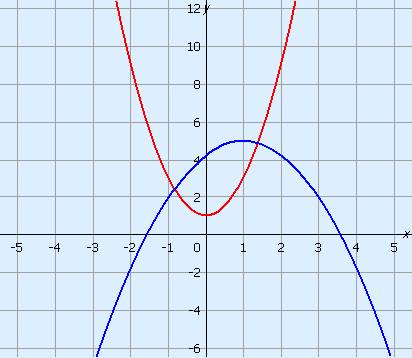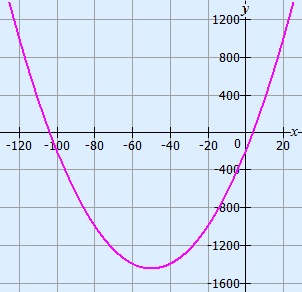Formulas, graphs & relations » Quadratic relation
Contents
1. General2. Formula
3. Table
4. Graph
5. Making quadratic formulas
1. General
A quadratic relation(ship) corresponds to a quadratic formula. These formulas are often used to calculate the height of falling rocks, kicked balls or an arched bridge.
A quadratic formula is sometimes called a second degree formula.
2. Formula
When you simplify the formula of a quadratic relation (remove the brackets), you will get 2 as the highest exponent for a variable, for example x2. The formula of a quadratic relation is often one of the following three formats:
| y = ax2 + bx + c | Parameter c is the intersection with the vertical axis. |
| y = a(x – p)2 + q | Parameters p and q are the coordinates of the vertex (p, q). |
| y = a(x – m)(x – n)2 | Parameters m2and n are the x-coordinates of the intersections with the horizontal axis. |
Examples
|
y = 3x2 |
The intersection with the vertical axis is (0, 0). |
| y = –x2 + 5x – 8 | The intersection with the vertical axis is (0, –8). |
| y = –4(x – 5)2 + 6 | The coordinates of the vertex are (5, 6). |
| y = 3(x + 2)2 – 8 | The coordinates of the vertex are (–2, –8). |
| y = –2(x + 7)(x – 5)2 | The2intersections with the horizontal axis are (–7, 0) and (5, 0). |
Non-examples
| y = 2x3 – 5x2 | The highest exponent is 3 instead of 2. |
| y = 3x + 52 | Simplifying gives y = 3x + 25 and that is a linear formula. |
| y = 2(3x + 4)2 | Simplifying gives y = 6x + 8 and that is a linear formula. |
| y = 3x(3x + 8) – 9x2 | Simplifying gives y = 24x and that is a linear formula. |
3. Table
Below you can find an example of a table that corresponds to a quadratic relation.
The corresponding formula is y = 2x2 + 1.
| x | –3 | –2 | –1 | 0 | 1 | 2 | 3 | |||||||
| y | 19 | 9 | 3 | 1 | 3 | 9 | 19 | |||||||
 –10 |
 –6 |
 –2 |
 +2 |
 +6 |
 +10 |
|||||||||
 +4 |
 +4 |
 +4 |
 +4 |
 +4 |
||||||||||
This is a quadratic relation due to the fact that the increase of the increase is equal.
The symmetry in the table says nothing about the table corresponding to a quadratic relation. Do not make that mistake. There are symmetric tables which do not correspond to a quadratic relation.
4. Graphs
Below you will see two examples of graphs that corresponds to quadratic relations. The shape of the graph is called a parabola. When you have to plot the graph of a quadratic relation always show the significant points in your graph, the vertex and the intersections with the axes. It is possible there are no intersections with the x-axis.
The red graph corresponds to the table above.

The maximum or minimum of the graph is called the vertex.
The vertex of the red parabola, that opens upward, lies at (0, 1).
The vertex of the blue parabola, that opens downward, lies at (1, 5).
The closer a (the number in front of x2) is by 0, the wider the parabola is.
The red graph is an upward opening parabola and has a positive value for a.
The blue graph is a downward opening parabola and has a negative value for a.
As said, you always have to show the significant points like the vertex and intersections with the axes. Often these points are around the origin, but with larger values for b and c you may have to search a while.
You might want to calculate those points before you start plotting.
To calculate the vertex, you use xvertex = –b2a with y = ax2 + bx + c
To calculate the intersections with the x-axis you solve the equation with y = 0.
Example
Plot the graph for the formula 0,5x2 + 50x – 200.
Calculate the vertex:
xvertex = –502 × 0.5 = –50
yvertex = 0.5(–50)2 + 50 × –50 – 200 = –1450.
Then the intersections with the horizontal axis (see quadratic equations):
0.5x2 + 50x – 200 = 0
a = 0.5 b = 50 c = –200
D = 502 – 4 × 0.5 × –200 = 2900
x = –50 +  2 × 0.5 2 × 0.5 | or x = –50 –  2 × 0.5 2 × 0.5 |
| x ≈ 3.85 | or x ≈ –103.85 |
Now you can make a table in which all three points are covered.
| x | –120 | –100 | –80 | –60 | –50 | –40 | –20 | 0 | 20 |
| y | 1000 | –200 | –1000 | –1400 | –1450 | –1400 | –1000 | –200 | 1000 |
Now you can plot the graph.

5. Making quadratic formulas
When you have to make a quadratic formula, you have to use one of the three forms of the quadratic formula.
Vertex
If the vertex is given, together with another point:
y = a(x – p)2 + q
Where p and q are the coordinates of the vertex (p, q).
Intersections with the horizontal axis
If the intersections with the horizontal axis are given, together with another point:
y = a(x – m)(x – n)
Where m and n are the intersections with the horizontal axis.
Intersection with the vertical axis
If three points are given, with one of them the intersection with the vertical axis:
y = ax2 + bx + c
Example 1
Of a parabola it is known that the vertex lies at (–4, 6).
Furthermore, this parabola goes through (–8, 14).
Make the corresponding formula.
Answer
We know the vertex, so we use y = a(x – p)2 + q.
Fill in the vertex. You get y = a(x – –4)2 + 6 = a(x + 4)2 + 6
Make the equation that belongs to the other point.
| 14 | = a(–8 + 4)2 + 6 |
| 14 | = a(–4)2 + 6 |
| 14 | = 16a + 6 |
| 16a | = 8 |
| a | = 816 = 12 |
The formula is y = 12(x + 4)2 + 6.
Example 2
Of a parabola it is known that it intersects the horizontal axis in (–4, 0) and in (8, 0). This parabola also goes through (5, –9).
Make the corresponding formula.
Answer
We know the intersections with the horizontal axis, therefore we use y = a(x – m)(x – n).
Filling in the intersections with the horizontal axis (m = –4 and n = 8) gives y = a(x + 4)(x – 8).
Now only a remains to be determined. Use an equation to do this.
For x = 5 the formula should answer y = –9.
This results in the following equation.
| –9 | = a(5 + 4)(5 – 8) |
| –9 | = a × 9 × –3 |
| –9 | = –27a |
| a | = –9–27 = 13 |
The formula is y = 13(x + 4)(x – 8).
Example 3
Of a parabola it is known that it goes through (–2, 18), (4, –6) and (0, 6).
Make the corresponding formula.
Answer
There are three known points with one of them the intersection with the vertical axis, so we use y = ax2 + bx + c
Because of (0, 6), we known that c = 6.
We get y = ax2 + bx + 6.
Now we have to make simultaneous equations with the help of the other two points.
| (–2, 18) gives | a(–2)2 + b(–2) + 6 | = 18 |
| 4a – 2b + 6 | = 18 | |
| 4a – 2b | = 12 | |
| 2a – b | = 6 | |
| (4, –6) gives | a(4)2 + b(4) + 6 | = –6 |
| 16a + 4b + 6 | = –6 | |
| 16a + 4b | = –12 | |
| 4a + b | = –3 |
This gives the set of simultaneous equations:
 2a – b = 6
2a – b = 6
4a + b = –3
I choose to use rearranging and substitution to solve the simultaneous equations, but there are other ways too. See the link above.
4a + b = –3 gives b = –4a – 3
Substitution in the first equation gives:
| 2a – (–4a – 3) | = 6 |
| 2a + 4a + 3 | = 6 |
| 6a + 3 | = 6 |
| 6a | = 3 |
| a | = 12 |
Now we know a, it is easy to calculate b with b = –4a – 3.
b = –4 × 12 – 3 = –5
The formula is y = 12x2 – 5x + 6.